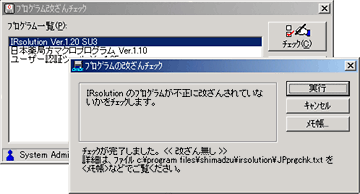(3) Changes Made with Supplement 1 to the Fourteenth Edition of the Japanese Pharmacopoeia; Validation, Periodic Inspection, and Operational Qualification; Software Validation
Changes Made with Supplement 1 to the Fourteenth Edition of the Japanese Pharmacopoeia
I imagine there are already people performing validation in accordance with the old version of the Japanese Pharmacopoeia. With supplement 1 to the fourteenth edition of the Japanese Pharmacopoeia, which was published on 27 December 2002, the specifications related to resolving power and wave-number precision were changed as shown in Table 1. Of particular note is the way that the definition of the figures in parentheses has been clarified, a point that caused a lot of misunderstanding.
Table 1 Changes Made to Japanese Pharmacopoeia
| Item | Fourteenth edition of Japanese Pharmacopoeia | Supplement 1 to Fourteenth Edition of Japanese Pharmacopoeia | ||||
|---|---|---|---|---|---|---|
| Resolving power (Resolution) | When the spectrum of a polystyrene film about 0.04 mm thick is recorded, the depth of the trough from the maximum absorption at about 2851 cm-1 to the minimum at about 2870 cm-1 should be not less than 18 % transmittance and that from the maximum at about 1583 cm-1 to the minimum at about 1589 cm-1 should not be less than 10 % transmittance. | When the spectrum of a polystyrene film about 0.04 mm thick is recorded, the depth of the trough from the maximum absorption at about 2850 cm-1 to the minimum at about 2870 cm-1 should be not less than 18 % transmittance and that from the maximum at about 1583 cm-1 to the minimum at about 1589 cm-1 should not be less than 12 % transmittance. | ||||
| Wave number accuracy |
The wave number (cm-1) scale is usually calibrated by the use of several absorption bands of a polystyrene film, shown below. The numbers in parentheses indicate theprecision with which these values have been established.
|
The wave number (cm-1) scale is usually calibrated by the use of several characteristic absorption wave numbers (cm-1) of a polystyrene film shown below. The number in parentheses indicatesthe permissible range.
|
Validation, Periodic Inspection, and Operational Qualification
Basically, the same way of thinking applies to validation, periodic inspection, and operational qualification. They all involve the inspection and correction of FTIR systems at regular intervals using specified techniques. At Shimadzu, we recommend using the validation program to perform periodic inspection and operational qualification.
Software Validation
In addition to checking that the hardware is operating properly, it is also necessary to check that the software is operating properly. FTIR software has, however, become very complex and it is impossible for the user to check all the functions using black-box tests involving the input and output of test data.

Execution of Alteration-Check Program
Software differs from hardware in that the influence of the manufacturing process for each individual product on the quality of that product is minimal and the product quality is determined almost entirely by the development process.
Therefore, the user checks that software's configuration files have not been corrupted or deleted using the alteration-check program and also checks that the main functions, such as the security functions and the basic data analysis functions, operate properly.
The software development is validated by the appropriate implementation of computer validation at the time of development.


